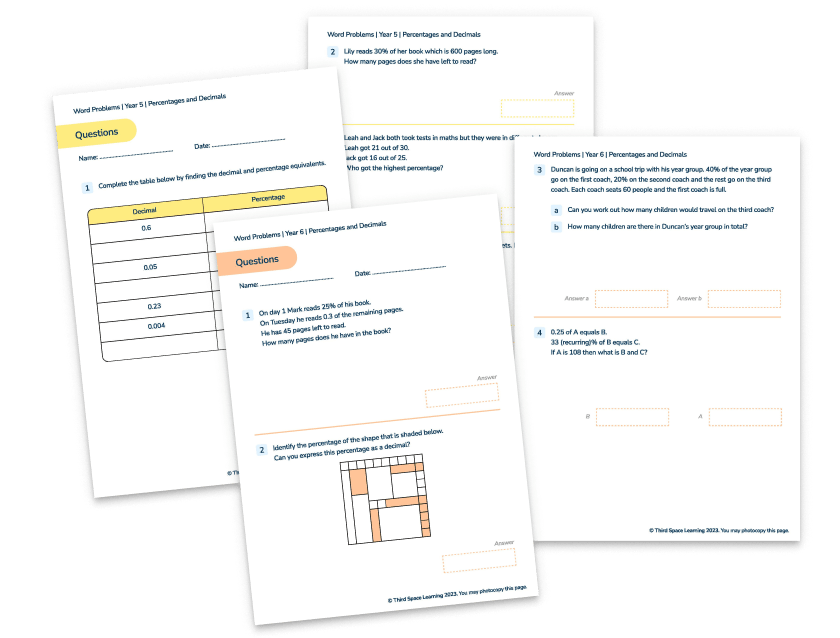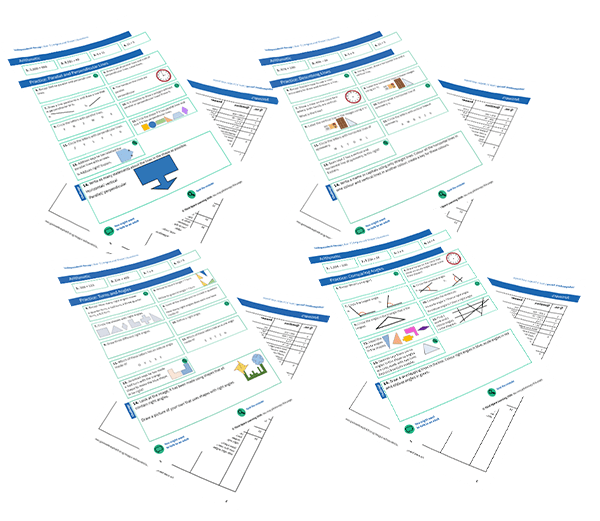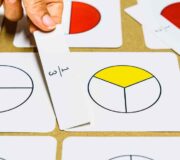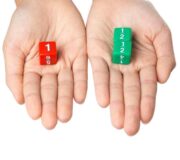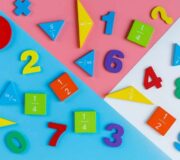How To Help Your Students When Comparing Fractions, Decimals, And Percentages
Comparing fractions, decimals and percentages can sound a little scary to parents, teachers and children alike, but they don’t have to be. Quite simply, fractions, decimals and percentages all represent parts of a whole. However, with them all looking so different, you’d be forgiven for getting confused about which is which and what to do when comparing fractions, decimals and percentages.
If this is something that causes confusion for your students, don’t panic as this guide will help both you and your students to understand the relationship between all three types of number. It’ll also explain what common core knowledge your students will be expected to know for all three topics in each school year to enable you to help them figure out fractions, decipher decimals and prevail over percentages.
But, before you find out everything you need to know about fractions, decimals and percentages for students, we’ve created a quick recap section for you to go over anything your students may have forgotten.
- Fractions, decimals and percentages in a nutshell – The things you may have forgotten since school!
- What does a child need to know about fractions, decimals and percentages in KS1 and KS2?
- What is the relationship between percentages, fractions, and decimals?
- How to help your child when they are converting fractions to decimals
- How to help your child when they are converting percentages to decimals
- Introducing your child to the fractions – decimals – percentages triangle
- How you can practice comparing fractions, decimals and percentages with your child at home
Fractions, decimals and percentages in a nutshell – The things you may have forgotten since school!
We may see and use them inadvertently in everyday life, but just how much do you remember about fractions, decimals and percentages and the relationship between them from your time in school?
If you’ve got some gaps in your memory about these three cornerstones of maths, then here’s a quick run through of everything you need to know!
What is a fraction?
Fractions are used to represent smaller pieces (or parts) of a whole.
The parts might make up one thing, or more than one thing. Either way, altogether, they make up what’s called a whole.
It’s important to note that a whole can mean more than one thing, and it’s useful to think of a sweet shop as an analogy.
For sharing a singular whole amount, you can think of a chocolate bar, a cake bar, or muffin.
For grouping an amount into fractional parts, you can imagine a bag of sweets – there are lots of sweets in the bag, but you need all of them to make up the whole bag.
A fraction has two parts – a numerator (the number on top of the line) and the demoninator (the bottom number underneath the line). This shows the quantity of equal parts the whole is divided into. You can have different types of fractions based on their numerator and denominator, such as ones have like or unlike denominators.
Understanding and Comparing Fractions Worksheets
Download these FREE understanding and comparing fractions worksheets for Year 3 pupils, intended to help pupils independently practise what they've been learning.
Download Free Now!Where are fractions used?
When compared to decimals and percentages, fractions are probably seen least regularly on a daily basis, but nevertheless, fractions do still play an important role in our everyday lives.
Some examples of times when you’d use fractions are:
Recipes: ¼ of a spoon of baking powder and ½ a bar of chocolate form the beginning of a delicious cake recipe, and most other elements of food preparation involve fractions as measures in one way or another.
Eating food: You might not want to, but cutting that pizza into ¼ and sharing it around is definitely the right thing to do….
Splitting the bill: If you are out with 4 friends and want to split the bill, you’ll need to work out what ⅕ of it is, unless of course someone had a starter and a dessert and then that’s a different calculation all together…
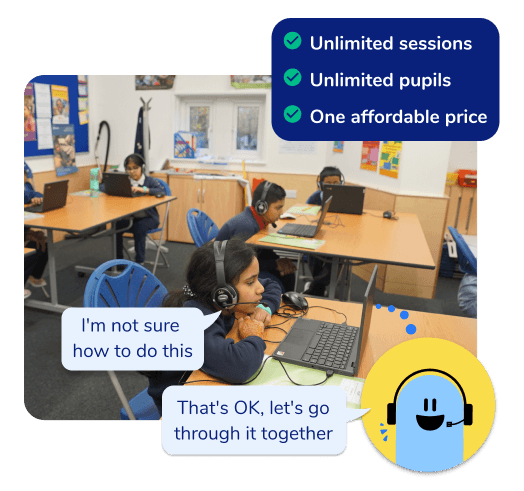
Unlimited primary maths tutoring with Skye, the voice-based AI maths tutor.
Built on the same principles, pedagogy and curriculum as our traditional tutoring but with more flexibility, reach and lower cost.
Join the schools already helping hundreds of primary pupils nationwide with Skye’s one to one maths tutoring
Watch Skye in actionWhat is a decimal?
It can be hard to know how to explain decimals to a child, but here is a simple answer:
A decimal is a way of writing a number that is not a whole number.
They are used to write ‘in between’ numbers. An example would be 9.4 as it is more than 9, but less than 10.
Where are decimals used?
Decimals are used often in everyday life, especially when a high level of precision is needed within the numbers for each decimal method.
Examples of places you may see decimals include:
Money: You might be paying £2.99 for your lunchtime meal-deal or £449.49 for a new laptop, but either way, decimals are involved.
Weight: If you are measuring ingredients in the kitchen on electric scales, you’ll be able to make sure that you get exactly 156.5 grammes of flour.
Length and width: Ensuring that you’ve measured exactly 95.6cm when trying to get a sofa through a door frame can be the difference between success and failure!
What is a percentage?
A percentage, shown by the % symbol, literally means ‘out of 100’.
So for example:
39% means 39 out of 100
96% means 96 out of 100
4% means 4 out of 100
Where are percentages used?
Percentages are most often seen in supermarkets or other shops, advertising a discount that is supposed to entice shoppers to part with their hard earned money, but they can also be seen in other locations in our daily lives.
Examples include:
Sales in shops: That pair of trainers is finally 50% off? Fantastic!
Food labels: Percentages are used to tell you how much a certain food or drink will contribute to your daily calorie allowance.
Tax: More often than not, everyone’s least favourite use of percentages, taxes are expressed in percentages due to the fact that the things they are being applied to are all different prices.
So why is comparing fractions, decimals and percentages important?
In short, fractions, decimals and percentages are all ways to describe the same thing, but they are used in different scenarios.
For example, one half can be written as:
Fraction: ½
Decimal: 0.5
Percentage: 50%
You might cut a cake in ½, whilst having £0.50 in your pocket and then take a look through a 50% off sale online.
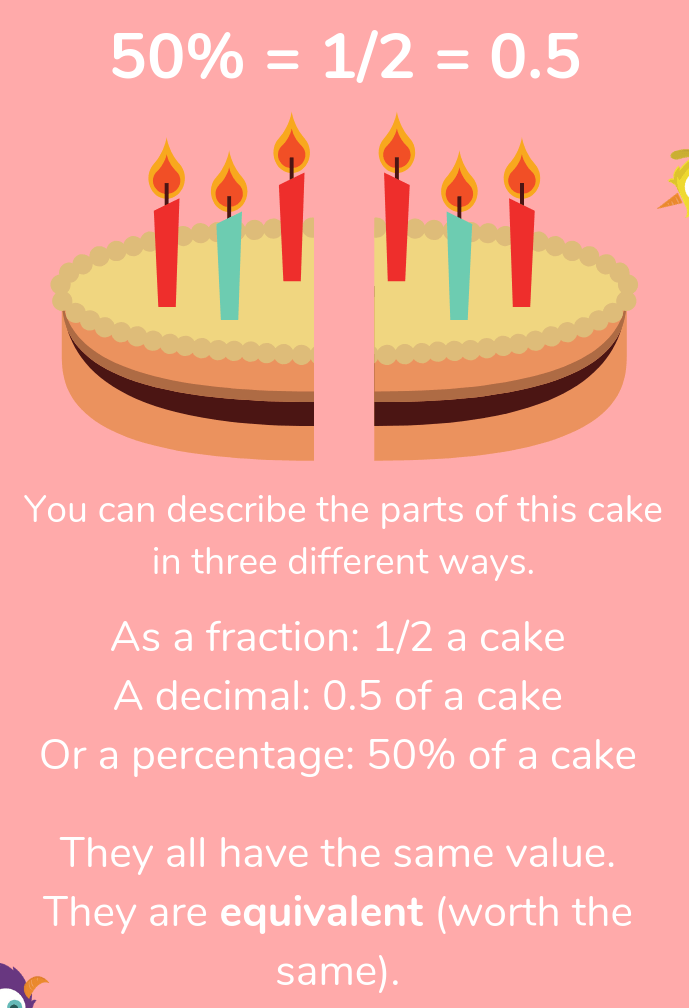
Understanding fractions, decimals and percentages is a very important part of everyday life, so your child will need to know how to convert between all of them!
What does a child need to know about fractions, decimals and percentages in KS1 and KS2?
As a child progresses through primary school, they will need to add to and develop their skills when it comes to converting between fractions, decimals and percentages.
To help you understand what children need to know on a year by year basis, we’ve broken things down and using the national curriculum, made clearer what your child is expected to learn and know as they progress through primary school.
What children need to know about fractions, decimals and percentages in Year 1
In Year 1, pupils are just beginning to become familiar with the concept of half and quarter, and they will be taught to:
- Recognise, find and name a half as one of two equal parts of an object, shape or quantity
- Recognise, find and name a quarter as one of four equal parts of an object, shape or quantity
What children need to know about fractions, decimals and percentages in Year 2
This year, pupils will be introduced to fractions in greater depth, and they will be taught to:
- Recognise find, name and write fractions ⅓, ¼, 2/4, and ¾ of a length, shape, set of objects or quantity
- Write simple fractions. For example, ½ of 6 = 3 and recognise the equivalence of 2/4 and ½
In Year 2 pupils should also be able to count fractions up to 10 whilst starting from any number and using ½, 2/4, ¾ on the number line. For example 3, 3 ¼, 3 ½, 3 ¾, 4.
What children need to know about fractions, decimals and percentages in Year 3
Year 3 is when things begin to take a step up for children when it comes to fractions.
Whilst fractions are the only element of the three that your child will be learning about, they will be taught how to do the following in Year 3:
- Count up and down in tenths
- Recognise that tenths arise from dividing an object into 10 equal parts, and by dividing one- digit numbers or quantities by 10
- Recognise, find and write fractions of a finite set of objects, with unit fractions and non-unit fractions with small denominators
- Recognise and use fractions as numbers
- Recognise and show using diagrams, equivalent fractions with small denominators
- Use the process of how to add fractions and subtracting fractions with the same denominator within a whole number
- Compare and order unit fractions, and fractions with the same denominators
- Solve problems involving all of the above
What children need to know about fractions, decimals and percentages in Year 4
In Year 4, your child will be introduced to decimals alongside learning more about fractions.
This year, they will be taught to:
- Recognise and show families of common equivalent fractions using diagrams
- Count up and down in hundredths; recognise that hundredths arise when dividing an object by one hundred and dividing tenths by ten.
- Solve problems involving increasingly harder fractions to calculate quantities, and fractions to divide quantities, including non-unit fractions where the answer is a whole number
- Add and subtract fractions with the same denominator
- Recognise and write decimal equivalents of any number of tenths or hundredths
- Recognise and write decimal equivalents to ¼, ½, ¾
- Find the effect of dividing a one- or two-digit number by 10 and 100, identifying the value of the digits in the answer as ones, tenths and hundredths
- Round decimals with one decimal place to the nearest whole number
- Compare numbers with the same number of decimal places up to two decimal places
- Solve simple measure and money problems involving fractions and decimals to two decimal places
What children need to know about fractions, decimals and percentages in Year 5
In Year 5 your child will be exposed to fractions, decimals and percentages for the first time. There is a lot more to learn this year, but with your help at home they will be able to tackle all that is thrown at them. This year your child will be taught how to:
- Compare and order fractions whose denominators are all multiples of the same number
- Identify, name and write equivalent fractions of a given fraction, represented visually, including tenths and hundredths
- Recognise mixed numbers and improper fractions and convert from one form to the other and write mathematical statements > 1 as a mixed number [for example, ⅖ + ⅘ = 6/5 = 1 ⅕]
- Add and subtract fractions with the same denominator and denominators that are multiples of the same number
- Multiply proper fractions and mixed numbers by whole numbers, supported by materials and diagrams
- Read and write decimal numbers as fractions [for example, 0.71 = 100/71 ]
- Recognise and use thousandths and relate them to tenths, hundredths and decimal equivalents
- Round decimals with two decimal places to the nearest whole number and to one decimal place
- Read, write, order and compare numbers with up to three decimal places
- Solve problems involving number up to three decimal places
- Recognise the per cent symbol (%) and understand that per cent relates to ‘number of parts per hundred’, and write percentages as a fraction with denominator 100, and as a decimal
- Solve problems which require knowing percentage and decimal equivalents of ½, ¼, ⅕, ⅖, ⅘ and those fractions with a denominator of a multiple of 10 or 25.
What children need to know about fractions, decimals and percentages in Year 6
Year 6 is the time when all of the learning your child has been doing in primary school is tested, but there are still a few things they will be taught about understanding and comparing fractions, decimals and percentages this year, including how to:
- Use common factors when going through the process of how to simplify fractions; use common multiples to express fractions in the same denomination
- Compare and order fractions, including fractions > 1
- Add and subtract fractions with different denominators and mixed numbers, using the concept of equivalent fractions
- Multiply simple pairs of proper fractions, writing the answer in its simplest form [for example, ¼ x ½ = ⅛ ]
- Divide proper fractions by whole numbers [for example, ⅓ ÷ 2 = ⅙ ]
- Associate a fraction with division and calculate decimal fraction equivalents [for example, 0.375] for a simple fraction [for example, ⅜]
- Identify the value of each digit in numbers given to three decimal places and multiply and divide numbers by 10, 100 and 1000 giving answers up to three decimal places
- Multiply one-digit numbers with up to two decimal places by whole numbers
- Use written division methods in cases where the answer has up to two decimal places
- Solve problems which require answers to be rounded to specified degrees of accuracy
- Recall and use equivalences between simple fractions, decimals and percentages, including in different contexts.
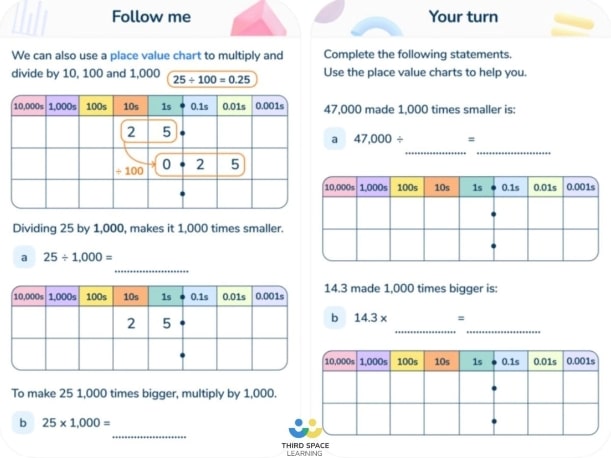
Read more:
- How To Divide Fractions: Step By Step Guide
- How To Multiply Fractions: Step By Step Guide
- 24 Fraction Questions And Answers
What is the relationship between percentages, fractions, and decimals?
Percentages, fractions, and decimals are in essence, different ways of writing the same thing.
There are some equivalents that come up more often than others, and it is worth learning them by heart so that you can calculate them faster.
The equivalents that tend to come up more often than others are:
| Percent | Fraction | Decimal |
| 1% | 1/100 | 0.01 |
| 5% | 1/20 | 0.05 |
| 10% | 1/10 | 0.1 |
| 12.5% | 1/8 | 0.125 |
| 20% | ⅕ | 0.2 |
| 25% | ¾ | 0.75 |
| 33.3% | ⅓ | 0.333… |
| 50% | ½ | 0.5 (or 0.50 – the value is the same) |
| 75% | ¾ | 0.75 |
| 80% | ⅘ | 0.8 |
| 90% | 9/10 | 0.9 |
| 99% | 99/100 | 0.99 |
We represent parts in different ways to make our calculations easier in different contexts.
For example, when we’re talking about money, it makes more sense to use decimals than fractions, because money is already in the decimal format.
Or, sometimes, choosing the right format before you calculate makes the steps of a problem clearer – working out 10% might seem daunting, but if you know it’s the same as 1/10, it’s clearer that we need to divide the whole by 10.
Thankfully, there are a number of ways to switch between percentages, decimals, and percentages.
We’ll go through each method step-by-step, then look at an easy technique you can use to help your child remember them.
How to help your child when they are converting decimals into percentages
There are two ways to convert decimals into percentages.
You can use fractions or multiplication, but the important thing is to use the process that works best for your child!
Here is the method when using fraction:
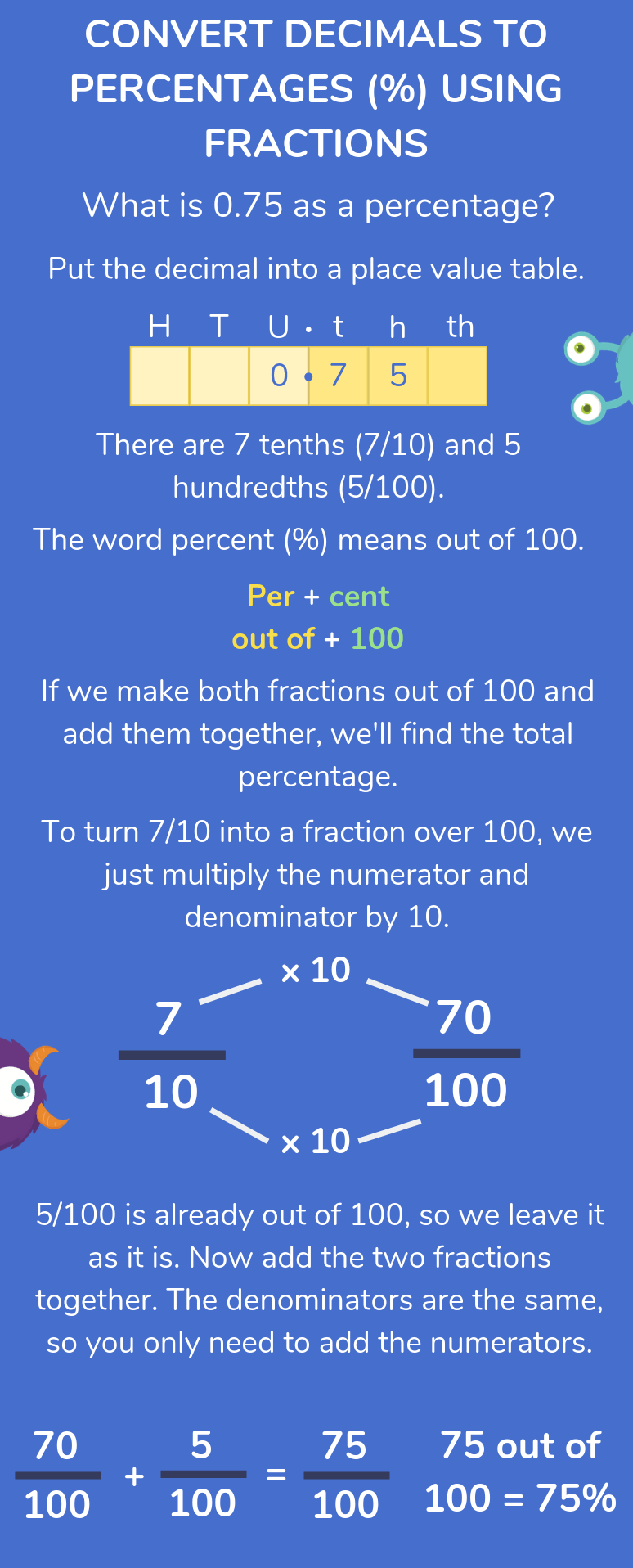
Here is the method when using multiplication:
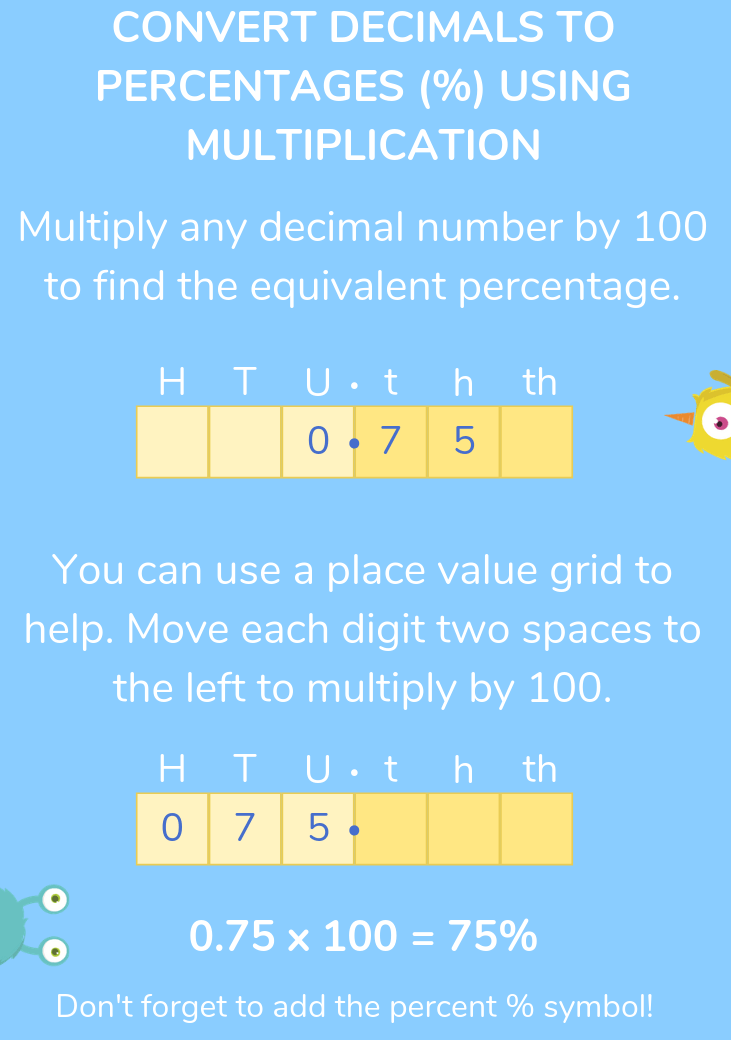
How to help your child when they are converting fractions to decimals
How you do this conversion depends on whether you’ve got a calculator handy or not.
If your child finds converting between equivalent fractions a bit tricky, check out our guide on how to help your child with fractions. The full method is covered there!
Method 1: Helping your child convert fractions to decimals without a calculator by using equivalent fractions
This method is extremely simple in theory, but it does involve some multiplication skills from your child.
However, if you sit down and show your child the theory being discussed in the image below they’ll pick it up in no time at all!
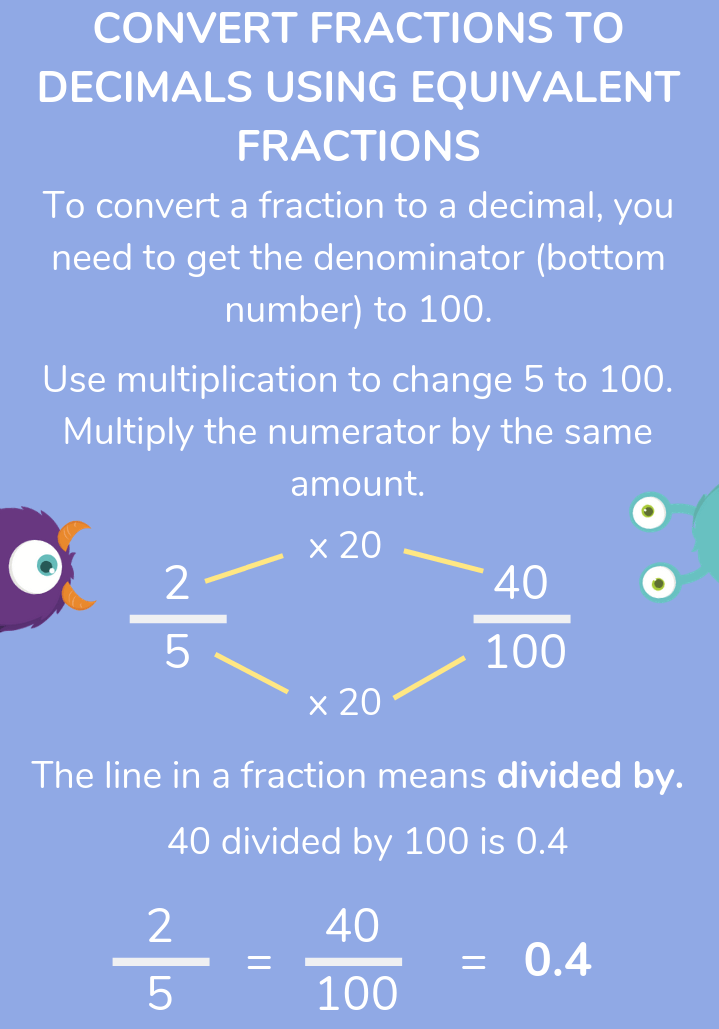
Method 2: Helping your child to convert fractions to decimals with a calculator by using division
This method is very simple.
All your child has to do is divide the numerator by the denominator and voila… They will have the equivalent decimal!
At some point, your child might come across some strange looking decimals, like 0.333… or 0.090909… that go on for what seems like forever.
That’s because they do!
You could write them over and over for the rest of your life and never be finished writing the whole decimal. To save time, we can write them with a dot above the recurring number, like this:
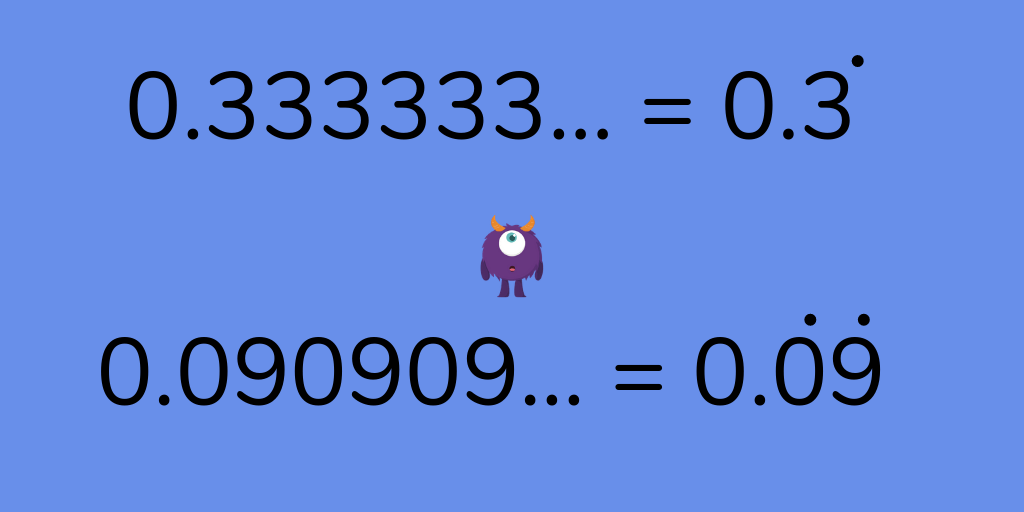
How to help your child when they are converting percentages to decimals
Although there are two ways to do this, they’re both very similar.
You should use whichever one your child prefers!
Method 1: Helping your child convert percentages to decimals using fractions
Take a look at the graphic below which explains how to do this in very simple terms!
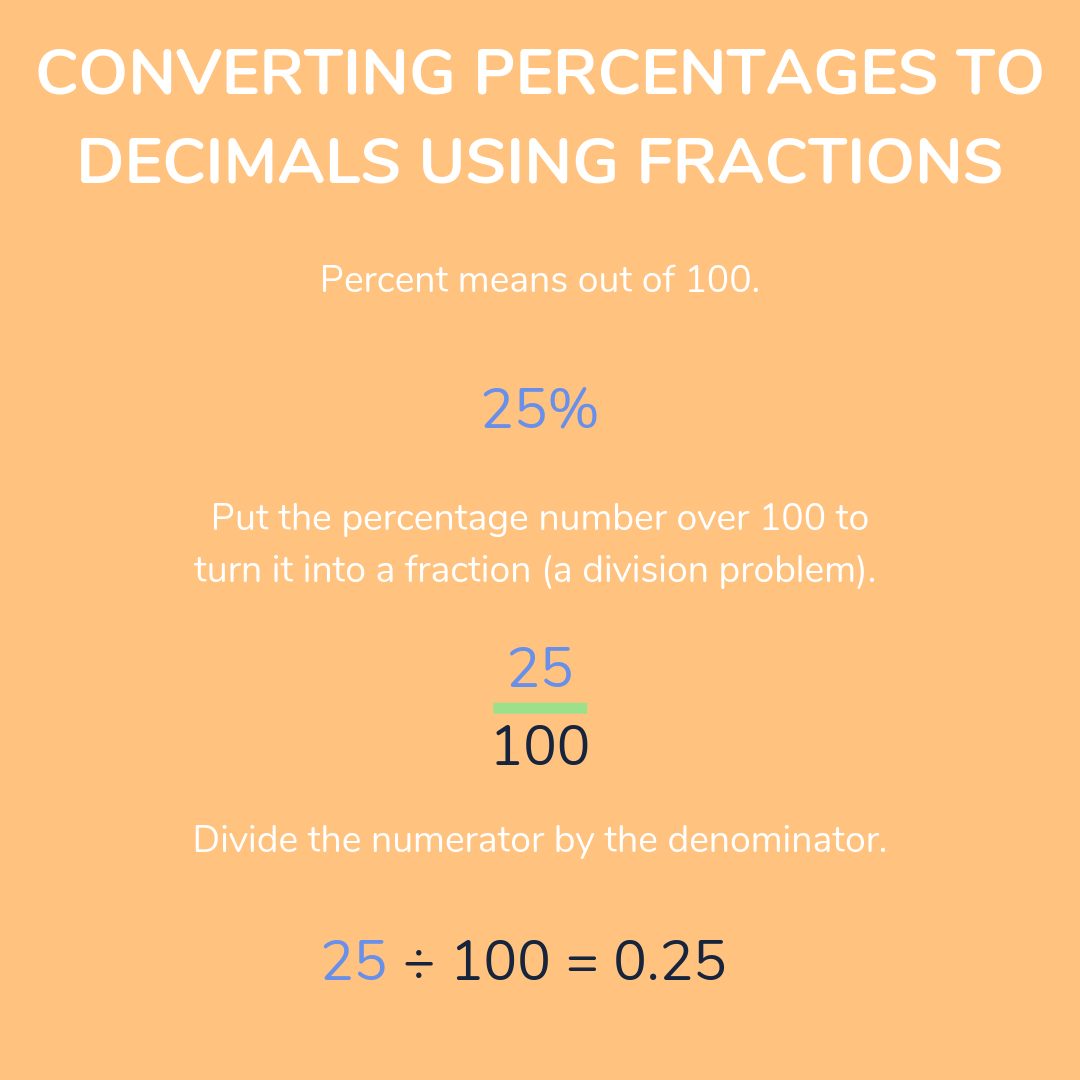
Method 2: Helping your child convert percentages to decimals using division
This method is so easy your child probably won’t believe it.
All they have to do is divide the percentage by 100 and there’s the equivalent decimal!
It’s the same as the last step in the previous method – we just skip the part where we turn the percentage into a fraction!
Introducing your child to the fractions – decimals – percentages triangle
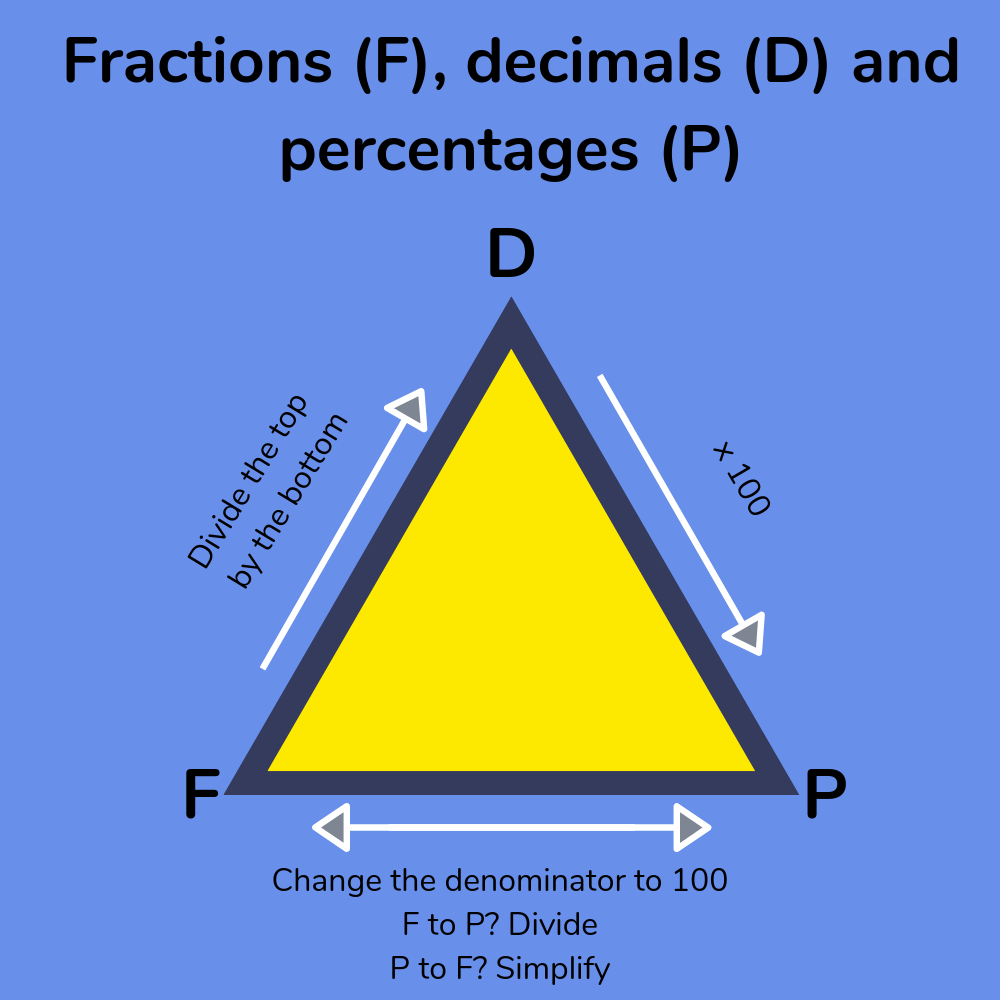
This visual aid can be really handy when you forget which process to use.
Keep it somewhere that is easily seen so your child (and you) can refer to it whenever it is needed!
How you can practice comparing fractions, decimals and percentages with your child at home
Fractions, decimals, and percentages may seem dull, but they’re actually more relevant to the real world than most other elements of primary school maths.
You’ll see them everywhere once you start looking, and this is something you should use to encourage your child to test their fractions, decimals and percentages skills!
Once they understand the real life relevance of fractions, decimals and percentages, they will be keener (and more willing) to learn all about them!
Read more: 10 Fun, Simple Fraction Games For KS1 & KS2
Ways you can practice converting between fractions, decimals and percentages at home with your child
There are a number of ways you can work on these maths skills with your child at home, and here are some simple ways you can practise.
Shopping stumpers
Get your child to work out discounts in the sale on the go, or challenge them to work out fractions of amounts when weighing up your fruit and veg on a scale.
Mix it up by throwing a decimal in there! Here are a few examples of what you could ask:
This says 20% off. What’s 20% worth? How much will it be once I subtract 20%?
The price is £1.50 per kilo. We only want half a kilo. How much will it be?
The sign says we can save ⅓ when we buy two of these items. How much would we be saving?
Deciphering fractions, decimals and percentages using money
This is a very simple activity but one that can help your child get to grips with all three formats using something they are already familiar with, namely money!
Using the change in your pocket, you can get your child to:
- Write down different amounts of money using decimals. As long as you always give them a pound coin, challenge them by varying the other amounts you give them to help them understand the value of hundreds, tens and ones.
- Work out percentages and fractions of a total amount. Give your child a £5 note and the equivalent amount in coins too. Challenge them to then work out what ½ of the £5 would be in coins, or what 75% would be.
Get baking and calculating
As has been touched upon earlier in the post, baking (and cooking in general) presents a great opportunity to practise fractions, decimals and percentages.
Recipes will often call for ½ of a cup, or 100.5g of flour, so by getting your child involved in the baking process they’ll be able to see how fractions, decimals and percentages are used in everyday life.
Make your own decimal stick
Visual representation is a great tool to use when teaching children, and that is certainly true when it comes to decimals for kids.
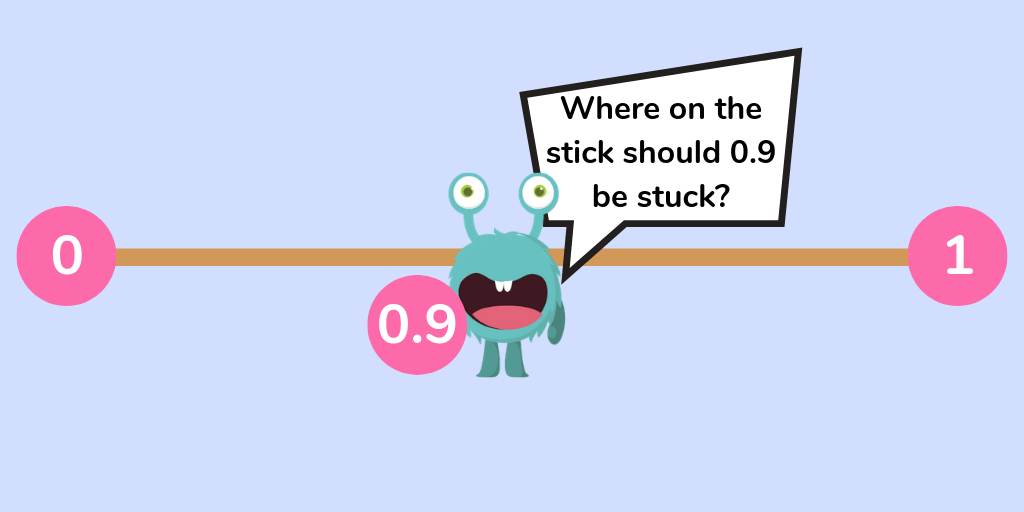
A decimal stick is a simple yet highly effective way to capitalise on the benefits of visual learning, and all you’ll need to make it is a cane (or stick) and some paper!
Place a number 1 on the right hand end of the stick and a 0 on the left hand end. Ask your child to place where 0.9 should go, and then you can place other decimals along the line.
DO YOU HAVE STUDENTS WHO NEED MORE SUPPORT IN MATHS?
Skye – our AI maths tutor built by teachers – gives students personalised one-to-one lessons that address learning gaps and build confidence.
Since 2013 we’ve taught over 2 million hours of maths lessons to more than 170,000 students to help them become fluent, able mathematicians.
Explore our AI maths tutoring or find out about a primary school maths tutor for your school.
